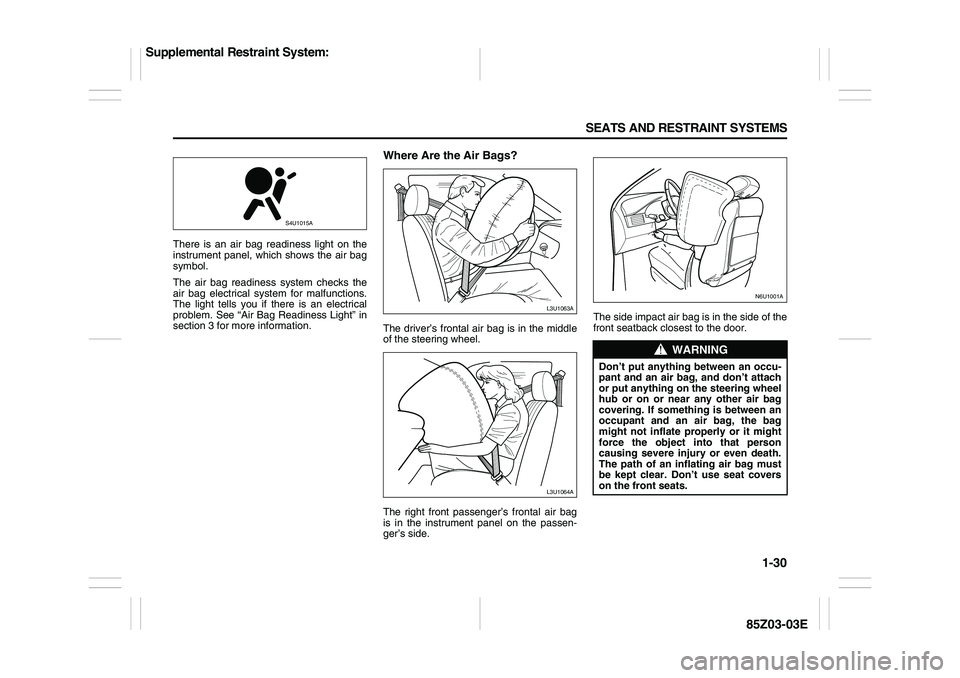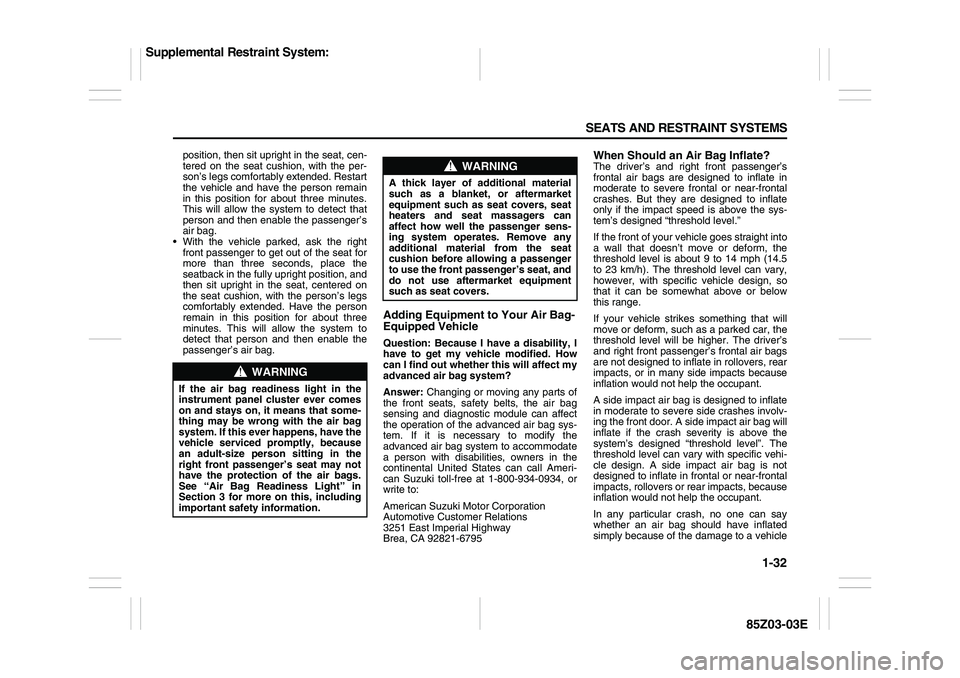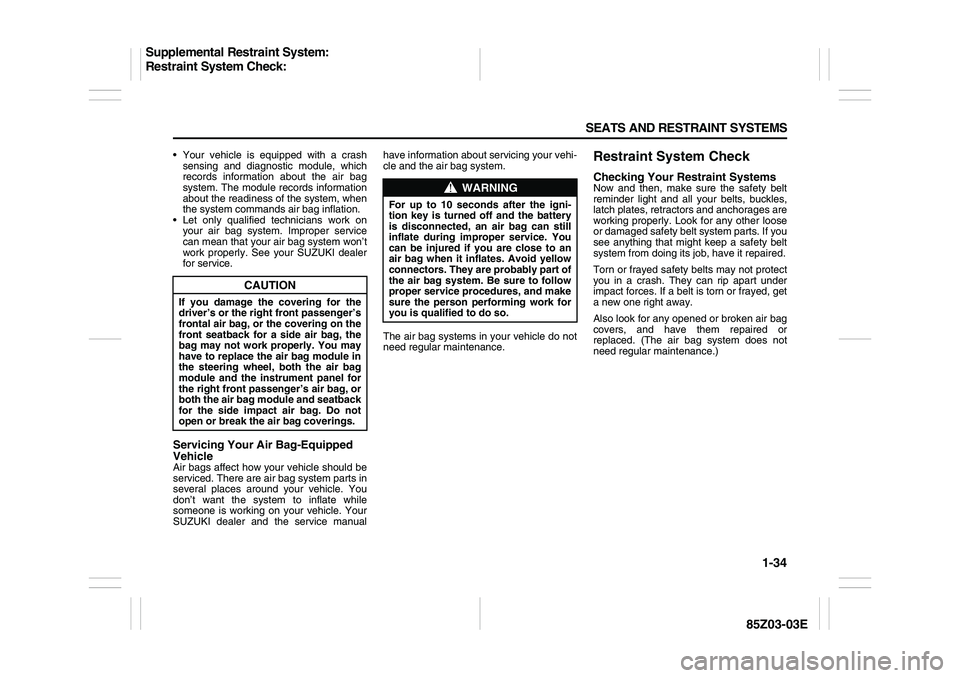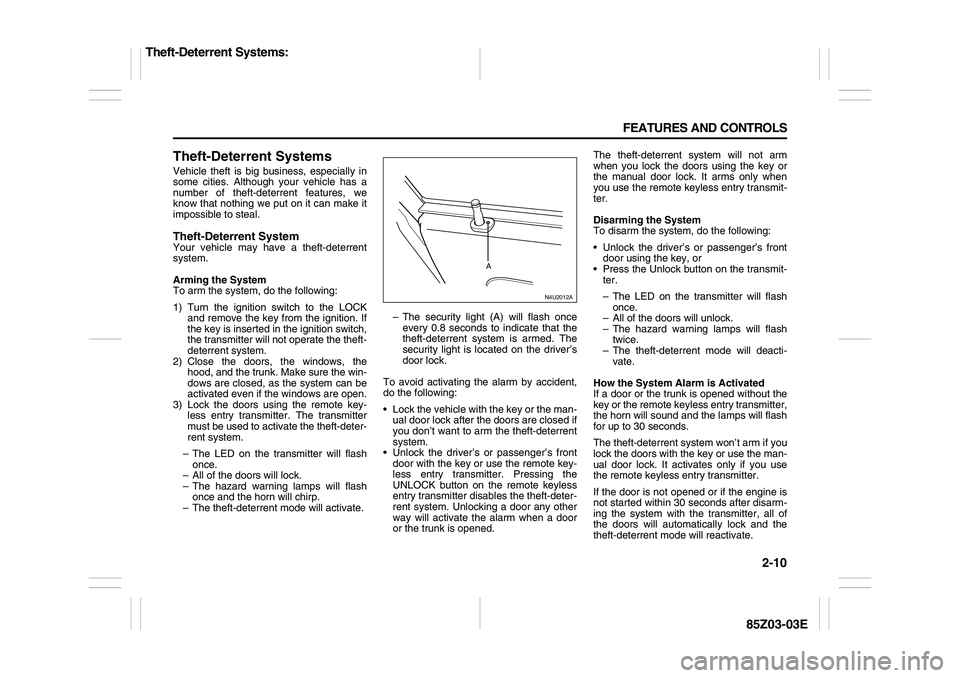2007 SUZUKI FORENZA light
[x] Cancel search: lightPage 42 of 225

1-30 SEATS AND RESTRAINT SYSTEMS
85Z03-03E
There is an air bag readiness light on the
instrument panel, which shows the air bag
symbol.
The air bag readiness system checks the
air bag electrical system for malfunctions.
The light tells you if there is an electrical
problem. See “Air Bag Readiness Light” in
section 3 for more information.
Where Are the Air Bags?The driver’s frontal air bag is in the middle
of the steering wheel.
The right front passenger’s frontal air bag
is in the instrument panel on the passen-
ger’s side.The side impact air bag is in the side of the
front seatback closest to the door.
S4U1015A
L3U1063AL3U1064A
WARNING
Don’t put anything between an occu-
pant and an air bag, and don’t attach
or put anything on the steering wheel
hub or on or near any other air bag
covering. If something is between an
occupant and an air bag, the bag
might not inflate properly or it might
force the object into that person
causing severe injury or even death.
The path of an inflating air bag must
be kept clear. Don’t use seat covers
on the front seats.
N6U1001A
Supplemental Restraint System:
Page 43 of 225

1-31 SEATS AND RESTRAINT SYSTEMS
85Z03-03E
Passenger Sensing SystemYour vehicle has a passenger sensing sys-
tem for the right front passenger position.
The passenger air bag off indicator will be
visible when you turn your ignition key to
ON or START. The words “PASSENGER
AIR BAG OFF” will be visible in the clock
display located in the center of the instru-
ment panel during the system check.
When the system check is complete, the
words “PASSENGER AIR BAG OFF”
should go out unless the passenger sens-
ing system has turned off the front passen-
ger’s frontal and side air bags. See
“Passenger Air bag Off Indicator” in Sec-
tion 3.
The passenger sensing system will turn off
the right front passenger’s frontal air bag
and side air bag under certain conditions.
The driver’s frontal air bag and side air bag
are not part of the passenger sensing sys-
tem. The passenger sensing system works
with sensors that are part of the right front
passenger’s seat cushion. The sensors are
designed to detect the presence of a prop-
erly-seated occupant and determine if the
passenger’s frontal air bag and side air
bag should be enabled (may inflate) or not.The passenger sensing system is
designed to turn off the right front passen-
ger’s frontal air bag and side air bag when
the weight on the front seat is 25.6 kg (56.4
lbs) or less. The air bag should be turned
off in the following situations.
the right front passenger seat is unoccu-
pied.
the system determines that an infant or a
small child is present in the right front
passenger seat.
a right front passenger takes his/her
weight off of the seat for a period of time. there is a critical problem with the air bag
system or the passenger sensing sys-
tem.
When the passenger sensing system has
turned off the passenger’s frontal air bag
and side air bag, the passenger air bag off
indicator in the clock display will light and
stay lit to remind you that the air bags are
off. See “Passenger Air Bag Off Indicator”
in Section 3.
Accident statistics show that children are
safer if they are restrained in the rear
rather than the front seat. We recommend
that child restraints be secured in the rear
seat.
For some children who have outgrown
child restraints and for very small adults,
the passenger sensing system may or may
not turn off the right front passenger’s fron-
tal air bag and side air bag, depending
upon the person’s seating posture and
body build. Everyone in your vehicle who
has outgrown child restraints should wear
a safety belt properly – whether or not
there is an air bag for that person.
If a person of adult-size is sitting in the
right front passenger’s seat, but the pas-
senger air bag off indicator is lit, it could be
because that person is not sitting properly
in the seat. If this happens, do one of the
following:
Turn the vehicle off and ask the person
to place the seatback in the fully upright
N5U1002AS
PASSENGER
AIR BAG OFF
WARNING
A child in a rear-facing child restraint
can be severely injured or killed if the
right front passenger’s frontal air bag
inflates. This is because the back of
the rear-facing child restraint would
be very close to the inflating air bag.
Even though the passenger sensing
system is designed to turn off the
passenger’s frontal air bag and side
air bag under certain conditions, no
system is fail-safe, and no one can
guarantee that an air bag will not
deploy under some unusual circum-
stance, even though it is turned off.
Always secure a rear-facing child
restraint in the rear seat, even if the
air bags are off.
Supplemental Restraint System:
Page 44 of 225

1-32 SEATS AND RESTRAINT SYSTEMS
85Z03-03E
position, then sit upright in the seat, cen-
tered on the seat cushion, with the per-
son’s legs comfortably extended. Restart
the vehicle and have the person remain
in this position for about three minutes.
This will allow the system to detect that
person and then enable the passenger’s
air bag.
With the vehicle parked, ask the right
front passenger to get out of the seat for
more than three seconds, place the
seatback in the fully upright position, and
then sit upright in the seat, centered on
the seat cushion, with the person’s legs
comfortably extended. Have the person
remain in this position for about three
minutes. This will allow the system to
detect that person and then enable the
passenger’s air bag.
Adding Equipment to Your Air Bag-
Equipped VehicleQuestion: Because I have a disability, I
have to get my vehicle modified. How
can I find out whether this will affect my
advanced air bag system?
Answer: Changing or moving any parts of
the front seats, safety belts, the air bag
sensing and diagnostic module can affect
the operation of the advanced air bag sys-
tem. If it is necessary to modify the
advanced air bag system to accommodate
a person with disabilities, owners in the
continental United States can call Ameri-
can Suzuki toll-free at 1-800-934-0934, or
write to:
American Suzuki Motor Corporation
Automotive Customer Relations
3251 East Imperial Highway
Brea, CA 92821-6795
When Should an Air Bag Inflate?The driver’s and right front passenger’s
frontal air bags are designed to inflate in
moderate to severe frontal or near-frontal
crashes. But they are designed to inflate
only if the impact speed is above the sys-
tem’s designed “threshold level.”
If the front of your vehicle goes straight into
a wall that doesn’t move or deform, the
threshold level is about 9 to 14 mph (14.5
to 23 km/h). The threshold level can vary,
however, with specific vehicle design, so
that it can be somewhat above or below
this range.
If your vehicle strikes something that will
move or deform, such as a parked car, the
threshold level will be higher. The driver’s
and right front passenger’s frontal air bags
are not designed to inflate in rollovers, rear
impacts, or in many side impacts because
inflation would not help the occupant.
A side impact air bag is designed to inflate
in moderate to severe side crashes involv-
ing the front door. A side impact air bag will
inflate if the crash severity is above the
system’s designed “threshold level”. The
threshold level can vary with specific vehi-
cle design. A side impact air bag is not
designed to inflate in frontal or near-frontal
impacts, rollovers or rear impacts, because
inflation would not help the occupant.
In any particular crash, no one can say
whether an air bag should have inflated
simply because of the damage to a vehicle
WARNING
If the air bag readiness light in the
instrument panel cluster ever comes
on and stays on, it means that some-
thing may be wrong with the air bag
system. If this ever happens, have the
vehicle serviced promptly, because
an adult-size person sitting in the
right front passenger’s seat may not
have the protection of the air bags.
See “Air Bag Readiness Light” in
Section 3 for more on this, including
important safety information.
WARNING
A thick layer of additional material
such as a blanket, or aftermarket
equipment such as seat covers, seat
heaters and seat massagers can
affect how well the passenger sens-
ing system operates. Remove any
additional material from the seat
cushion before allowing a passenger
to use the front passenger’s seat, and
do not use aftermarket equipment
such as seat covers.
Supplemental Restraint System:
Page 46 of 225

1-34 SEATS AND RESTRAINT SYSTEMS
85Z03-03E
Your vehicle is equipped with a crash
sensing and diagnostic module, which
records information about the air bag
system. The module records information
about the readiness of the system, when
the system commands air bag inflation.
Let only qualified technicians work on
your air bag system. Improper service
can mean that your air bag system won’t
work properly. See your SUZUKI dealer
for service.Servicing Your Air Bag-Equipped
VehicleAir bags affect how your vehicle should be
serviced. There are air bag system parts in
several places around your vehicle. You
don’t want the system to inflate while
someone is working on your vehicle. Your
SUZUKI dealer and the service manualhave information about servicing your vehi-
cle and the air bag system.
The air bag systems in your vehicle do not
need regular maintenance.
Restraint System CheckChecking Your Restraint SystemsNow and then, make sure the safety belt
reminder light and all your belts, buckles,
latch plates, retractors and anchorages are
working properly. Look for any other loose
or damaged safety belt system parts. If you
see anything that might keep a safety belt
system from doing its job, have it repaired.
Torn or frayed safety belts may not protect
you in a crash. They can rip apart under
impact forces. If a belt is torn or frayed, get
a new one right away.
Also look for any opened or broken air bag
covers, and have them repaired or
replaced. (The air bag system does not
need regular maintenance.)
CAUTION
If you damage the covering for the
driver’s or the right front passenger’s
frontal air bag, or the covering on the
front seatback for a side air bag, the
bag may not work properly. You may
have to replace the air bag module in
the steering wheel, both the air bag
module and the instrument panel for
the right front passenger’s air bag, or
both the air bag module and seatback
for the side impact air bag. Do not
open or break the air bag coverings.
WARNING
For up to 10 seconds after the igni-
tion key is turned off and the battery
is disconnected, an air bag can still
inflate during improper service. You
can be injured if you are close to an
air bag when it inflates. Avoid yellow
connectors. They are probably part of
the air bag system. Be sure to follow
proper service procedures, and make
sure the person performing work for
you is qualified to do so.
Supplemental Restraint System:
Restraint System Check:
Page 53 of 225

2-5 FEATURES AND CONTROLS
85Z03-03E
manual door lock located on the window
sill on each door.
From the inside, you can also lock and
unlock the doors with the power door lock
switches located on the driver’s door trim
pad.Central Door Locking SystemThe central door locking system is acti-
vated using the switch on the driver’s door.
From the outside, you can lock or unlock all
of the doors on your vehicle from the
driver’s door by using either the key or the
optional keyless entry transmitter. From the
inside, you can lock or unlock all of the
doors using the driver’s power door lock
switch.
Power Door LocksIf your vehicle has this feature you can
unlock or lock the doors on your vehicle
using the driver’s door lock switch. Push
down the front part of the switch to unlock
the doors. Push down the back part of the
switch to lock the doors.
Door Ajar ReminderIf one of the doors on your vehicle is not
closed completely while the ignition is on,
the door ajar light on the instrument panel
will come on and stay on until the doors
are closed and completely latched.Rear Door Security LocksYour vehicle is equipped with rear door
security locks on each rear door. This fea-
ture helps prevent passengers from open-
ing the rear doors on your vehicle from the
inside.
CAUTION
If there is noise when opening or
closing the doors or while driving,
apply grease to door latch and hinge.
N4U2006A
S4U2029A
Doors and Locks:
Page 55 of 225

2-7 FEATURES AND CONTROLS
85Z03-03E
Remote Trunk Release
Press the remote trunk release button,
located on the side of the driver’s door trim,
to release the trunk lid.Emergency Trunk Release Handle
There is a glow-in-the-dark emergency
trunk release handle located inside the
trunk on the underside of the trunk lid. This
handle will glow following exposure to light.
The trunk can be opened from the inside
by pulling the release handle down.
WARNING
It can be dangerous to drive with the
trunk lid open because carbon mon-
oxide (CO) gas can come into your
vehicle. You can’t see or smell CO. It
can cause unconsciousness and
even death. If you must drive with the
trunk lid open or if electrical wiring or
other cable connections must pass
through the seal between the body
and the trunk lid:
Make sure all other windows are
shut.
Turn the fan on your heating or
cooling system to its highest speed
and select the control setting that
will force outside air into your vehi-
cle. See “Climate Control System”
in the Index.
If you have air outlets on or under
the instrument panel, open them all
the way.
See “Engine Exhaust” in the Index.
WARNING
Never operate the remote trunk
release button while your vehicle is
moving. An open trunk lid obscures
your rear view. That can result in a
collision causing damage to your
vehicle or other property, personal
injury, or even death.
N4U2009A
CAUTION
The emergency trunk release handle
is not designed to be used to tie
down the trunk lid or as an anchor
point when securing items in the
trunk. Improper use of the emergency
trunk release handle could damage it.
L3U2010A
Doors and Locks:
Page 58 of 225

2-10 FEATURES AND CONTROLS
85Z03-03E
Theft-Deterrent SystemsVehicle theft is big business, especially in
some cities. Although your vehicle has a
number of theft-deterrent features, we
know that nothing we put on it can make it
impossible to steal.Theft-Deterrent SystemYour vehicle may have a theft-deterrent
system.
Arming the System
To arm the system, do the following:
1) Turn the ignition switch to the LOCK
and remove the key from the ignition. If
the key is inserted in the ignition switch,
the transmitter will not operate the theft-
deterrent system.
2) Close the doors, the windows, the
hood, and the trunk. Make sure the win-
dows are closed, as the system can be
activated even if the windows are open.
3) Lock the doors using the remote key-
less entry transmitter. The transmitter
must be used to activate the theft-deter-
rent system.
– The LED on the transmitter will flash
once.
– All of the doors will lock.
– The hazard warning lamps will flash
once and the horn will chirp.
– The theft-deterrent mode will activate.– The security light (A) will flash once
every 0.8 seconds to indicate that the
theft-deterrent system is armed. The
security light is located on the driver’s
door lock.
To avoid activating the alarm by accident,
do the following:
Lock the vehicle with the key or the man-
ual door lock after the doors are closed if
you don’t want to arm the theft-deterrent
system.
Unlock the driver’s or passenger’s front
door with the key or use the remote key-
less entry transmitter. Pressing the
UNLOCK button on the remote keyless
entry transmitter disables the theft-deter-
rent system. Unlocking a door any other
way will activate the alarm when a door
or the trunk is opened.The theft-deterrent system will not arm
when you lock the doors using the key or
the manual door lock. It arms only when
you use the remote keyless entry transmit-
ter.
Disarming the System
To disarm the system, do the following:
Unlock the driver’s or passenger’s front
door using the key, or
Press the Unlock button on the transmit-
ter.
– The LED on the transmitter will flash
once.
– All of the doors will unlock.
– The hazard warning lamps will flash
twice.
– The theft-deterrent mode will deacti-
vate.
How the System Alarm is Activated
If a door or the trunk is opened without the
key or the remote keyless entry transmitter,
the horn will sound and the lamps will flash
for up to 30 seconds.
The theft-deterrent system won’t arm if you
lock the doors with the key or use the man-
ual door lock. It activates only if you use
the remote keyless entry transmitter.
If the door is not opened or if the engine is
not started within 30 seconds after disarm-
ing the system with the transmitter, all of
the doors will automatically lock and the
theft-deterrent mode will reactivate.
N4U2012A
A
Theft-Deterrent Systems:
Page 59 of 225

2-11 FEATURES AND CONTROLS
85Z03-03E
How to Turn Off the System Alarm
If the system alarm is active, it can be
deactivated using the following methods:
Press the Lock or Unlock button on the
remote keyless entry transmitter.
Unlock the driver’s or passenger’s front
door using the key.
Otherwise, the alarm will automatically
stop after 30 seconds. The system will
then lock the doors and reactivate the
theft-deterrent system.
How to Detect a Tamper Condition
If the hazard lamps flash once when the
Lock or Unlock button on your transmitter
is pressed, that means the theft-security
system alarm was triggered while you
were away.
Daily Inspection ChecklistBefore Driving1) Make sure that windows, mirrors, lights
and reflectors are clean and unob-
structed.
2) Visually check the tires for the following
points:
– the depth of the tread groove
– abnormal wear, cracks and damage
– loose wheel nuts
– existence of foreign material such as
nails, stones, etc.
Refer to “Tires” in the “SERVICE AND
APPEARANCE CARE” section for details.
3) Look for oil or other fluid leaks.
NOTE:
It is normal for water to drip from the air
conditioning system after use.
4) Make sure the hood is fully closed and
latched.
5) Check the headlights, turn signal lights,
brake lights and horn for proper opera-
tion.
6) Lock all doors.
7) Adjust the seat and adjustable head
restraints (if equipped).
8) Check the brake pedal.
9) Adjust the mirrors.
10)Make sure that you and all passengers
have properly fastened your safety
belts.11)Make sure that all warning lights come
on as the key is turned to the “ON” or
“START” position.
12)Check all gauges.
13)Make sure that the BRAKE light turns
off when the parking brake is released.
Once a week, or each time you fill your fuel
tank, perform the following under-hood
checks:
1) Engine oil level
2) Coolant level
3) Brake fluid level
4) Power steering (if equipped) fluid level
5) Windshield washer fluid level
6) Hood latch operation
Pull the hood release handle inside the
vehicle. Make sure that you cannot
open the hood all the way without
releasing the secondary latch. Be sure
to close the hood securely after check-
ing for proper latch operation. See the
item “Lubricate Locks, Hinges & Hood
Latch” under “Chassis and Body” in the
“MAINTENANCE SCHEDULE” section
for the lubrication schedule.
WARNING
Make sure the hood is fully closed
and latched before driving. If it is not,
it can fly up unexpectedly during
driving, obstructing your view and
resulting in an accident.
Theft-Deterrent Systems:
Daily Inspection Checklist: